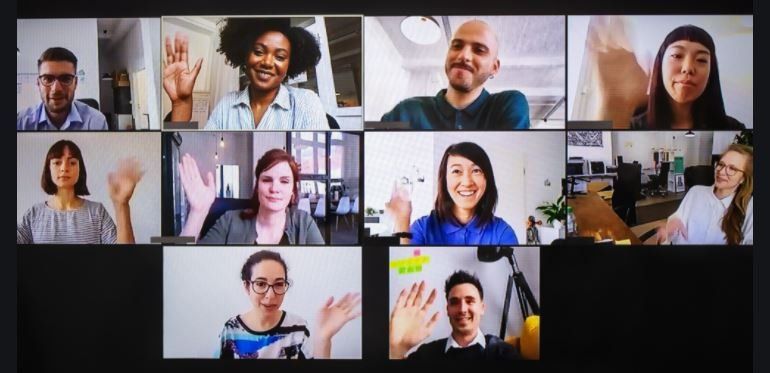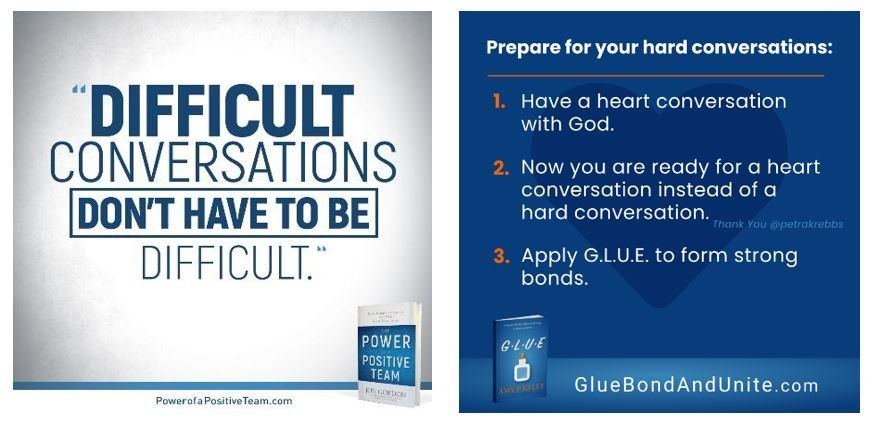Difficult Conversations Don't Have to Be Difficult
Difficult Conversations Don’t Have to Be Difficult
For employees and companies on Employee Appreciation Day
Have you ever entered a conversation with the best of intentions only to be pulled into a death spiral of emotions, destruction, and debate? Over the years as a Human Resources and Talent Development Executive and the co-creator of the Power of a Positive Team Consulting Program and Training, I’ve seen people avoid conversations because they were scared to have them, and I’ve seen some brave souls attempt to create collaboration but miss the mark by getting stuck defending their position while trying to prove their point.
This has happened on many topics but most often, I see these conversations around addressing poor performance, asking for greater compensation, defending an idea or a direction for a team, project or company, and any time a disagreement of perspective comes up that is important to the parties involved.
These conversations are some of the most powerful opportunities for unity and cohesion in the workplace. However, many times they become the place relationships, teams, and companies break and divide.
I also see people try so hard to be what they believe is professional that they leave out the role that human emotion plays in positive communication. You must be professional, but it is also personal. You have to approach significant conversations with the reality of the hearts and minds involved.
I’ve witnessed and participated in these types of challenging conversations over the years and set on a path to learn as much as possible to provide people and organizations with resources to capitalize on these opportunities to build stronger bonds and create top workplaces. With the right approach, it is possible to create unity instead of inflaming differences when topics challenge our communication skills. I work with teams to have difficult conversations and show them they don't have to be difficult.
Friday, March 4 is National Employee Appreciation Day. Using the tips outlined below, you can have positive outcomes that drive unity and cohesiveness in the significant work conversations that often get mismanaged by employers and employees without the right strategy.
There are many resources created to support team success. Over the years I’ve been exposed to some amazing training and development materials for productive, nourishing, inclusive, supportive, goal-aligned workplace conversations. I use many of them in my work developing leaders, teams and organizations.
As a leader, you know that preparation helps you have the positive conversational outcomes you intend. Consider using some of these techniques to increase your probability of success when having challenging conversations.
1) Redefine significant, challenging conversations in your mind.
I call them Heart Conversations instead of Hard Conversations. This terminology was shared by a colleague, friend, and Strengths Strategist Petra Krebbs. We were having a team discussion about my view that labeling conversations as difficult or hard is positioning ourselves for challenges before we even start. I used to call them business conversations or significant conversations. Petra shared with our team that she calls them Heart Conversations in her coaching work, and this rang true for a number of reasons.
First, you need to prepare your heart and examine your motives and intentions before having the significant conversation. Move through this eight-point checklist by asking yourself:
- Am I truly believing the best of the other individual?
- Am I ready to listen more than I talk?
- Am I willing to see the situation from their point of view?
- Am I calm and prepared to have the conversation with facts and examples without making personal attacks or getting easily offended?
- Am I prepared to disagree but still align at the end of the conversation to maintain unity and strong bonds?
- Am I prepared to keep the conversation confidential and not go to others to create sides or vent?
- Am I prepared to say I am wrong if the conversation uncovers something I might not have been aware of?
- Am I prepared to let the other person save face and not magnify a mistake the other person might have made?
If so, you are well on your way to having a Heart Conversation instead of a hard conversation. See? Don’t you already feel different just by labeling this interaction differently?
2) Visualize positive outcomes
Write out your thoughts and create a story of how the positive outcomes you intend for yourself and the other person look in your mind and build them on paper. Visualize the conversation going well and record the elements that are part of the story of success. Make sure to record the details you see in your mind. What environment is best to have the conversation? Notice the body language. How is eye contact happening? Are you listening intently? This reinforces the positive picture you’ve imagined by writing out the details on paper or in a typed document.
3) Practice privately with a trusted resource
This is not always necessary because going to the person and having the conversation directly is the best path. However, as you get better at these conversations, you can benefit from practicing your visualized and written scenario with someone you are confident will be honest and keep everything confidential. Many times a Human Resources leader is a fantastic option or a mentor you know is mature, neutral, and genuinely has everyone’s best interest and the company’s as a priority.
4) Complete final heart conversation preparations
A final step would be to assess the state of your heart. Really seek to examine it so that you feel as calm as possible. The clearer the picture you have of your intentions, the more the other person will be able to feel your authenticity. Hubert Joly’s book The Heart of Business is an excellent way to connect the heart of business to how you have effective conversations to bond and unite even in the most challenging communication circumstances. Joly says, “Purpose and human connections constitute the very heart of business.” I agree. Effective communication and the way we handle significant conversations are the life-giving blood pumping to and from that heart. Joly even has an electrocardiogram for your business on his book site.
Regardless, the days of imposing forced separation between your heart and your work are over (if they ever even truly existed), and developing the ability to have hard conversations as Heart Conversations will be a gift that you can give to your employees and your entire organization.
As we say in The Power of a Positive Team Training, "Difficult Conversations Don't Have to Be Difficult".
For additional reading, check out these resources that help shape successful teams:
- The Power of a Positive Team
- The Power of Positive Leadership
- Conversational Intelligence
- Crucial Conversations
- Everything DiSC Productive Conflict
- Disagree Agreeably and Diplomacy and Tact from Dale Carnegie
For support with your team's significant conversations and ongoing development leadership@amypkelly.com
####
Amy P. Kelly believes in people and helps them grow. The “P” in her name stands for the middle name she received from her grandmother Pauline and symbolizes the power on the inside of each person to fulfill their purpose. Amy is the Vice President of Consulting for The Jon Gordon Companies and co-author of The Energy Bus Field Guide a roadmap to fueling your life, work, and team with positive energy. Her work is focused on growth and optimal performance for individuals, teams, and organizations. She was recently published in the Association for Talent Development’s Global TD Magazine Mindset
Shifts for Better Human Performance Improvement. Her second book GLUE – A Leadership Strategy to Bond and Unite is a short story about leadership, faith, and forgiveness and is available at www.gluebondandunite.com.
Share This Article
Complete the form below for more information.








